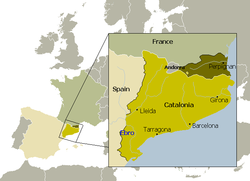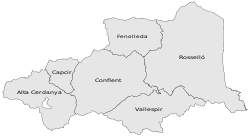Northern Catalonia
This article needs additional citations for verification. (March 2021) |
| Catalan / Valencian cultural domain |
|---|
  |
Northern Catalonia, North Catalonia
The equivalent term in French, Catalogne Nord, is used nowadays, although less often than the more politically neutral Roussillon (Catalan: Rosselló); Roussillon, though, historically did not comprise Vallespir, Conflent and Cerdagne (Cerdanya). The terms Pays Catalan (País Català), "Catalan Country" are sometimes used.
Geography

Northern Catalonia forms a triangle between the
The climate is of the Mediterranean type, with hot, dry summers and winters which are relatively mild, at least on the Roussillon plain where snow is rare.
The city of Perpignan (Catalan: Perpinyà) accounts for over a quarter of the population, over one-third of its urban area is taken into account, and is the only major administrative and service center. Major road and rail links run north–south through Northern Catalonia between France and Spain, while a railway line also links Perpignan to Latour-de-Carol (Catalan: La Tor de Querol) via Prades (Catalan: Prada de Conflent or Prada).
Cerdagne
The district lies on the most direct route between Toulouse (Occitan: Tolosa de Lengadoc) and Barcelona (via Foix and Ripoll), and a railway line still links the two cities via Latour-de-Carol (Catalan: La Tor de Querol).
Administrative history
Spanish marches and the County of Barcelona
Northern Catalonia formed part of the
As the seigneury of the counties became hereditary, the total number of Catalan counts fell steadily. One individual often had the charge of several counties, but these were not always transmitted based on
The
Crown of Aragon and the Monarchy of Spain
Royal administration in the
The
On the death of King
After the Treaty of the Pyrenees and cession to France

The
Present day
The département of the Pyrénées-Orientales is divided into the

Arrondissement
|
Cantons
|
Communes
|
Population (1999) | Area | Population density (1999) |
|---|---|---|---|---|---|
| Céret (Ceret) | 5 | 40 | 66,624 | 954 km2 | 69.8 /km2 |
| Perpignan (Perpinyà) | 20 | 86 | 287,272 | 1317 km2 | 218 /km2 |
| Prades (Prada) | 6 | 100 | 38,907 | 1845 km2 | 21.1 /km2 |
| TOTAL | 31 | 226 | 392,803 | 4116 km2 | 95.4 /km2 |
| All figures include the district of Fenouillèdes. | |||||
As is common, the present-day arrondissements do not correspond to pre-
Catalan writers sometimes speak of the "
Politics
The region is divided among those who support a union with France and those who support reuniting with
Northern Catalans are proud of their Catalan heritage and have developed a "Northern Catalan" identity. However, unlike their Southern neighbors in Spanish Catalonia, the Catalan identity is not a nationalist movement in French Catalonia. According to a 2020 study, French Catalans experienced mass education in the second half of the 19th century, leading them to adopt French patriotism. Catalans in Spain were mass educated in the early 20th century locally by Catalans and not by a strong Spanish state, which led to the formation of a salient Catalan national identity.[3]
In 2016, Northern Catalonia was merged with other areas of Occitania to form a new French region. This has led to fears that the Occitan language and culture will be given precedence over the Catalan language and culture.[1]
In December 2017,
Language and culture

Prominence of Catalan heritage
Language
Catalan is spoken in all regions of Northern Catalonia except for
In Perpignan, where a quarter of the population lives, 44% know the Catalan language.[2]
Culture
The Catalan folk dance Sardana is a dance in the region. Northern Catalans support the USAP rugby union team and the Catalans Dragons rugby league team.[2] There are four castells (Catalan human towers) teams in Northern Catalonia.[6]
Recognition
French is the only official language in France as a whole, and therefore of these municipalities. Catalan, in its Northern Catalan variety, is however recognized as a regional language by the region of Languedoc-Roussillon which contains Northern Catalunya; this recognition provides cultural support in education and public media, with some more regional power since the laws of regionalization of France during the 1980s. The language is estimated to be spoken by 34% of the population of Northern Catalonia,[7] but understood by 65%.
On 10 December 2007, the
Suppression
In 1700, the government of Louis XIV prohibited the use of the Catalan language in official documents,[10] although the government only irregularly enforced the edict throughout the eighteenth century.[11]
In Perpignan Catalan was also prohibited from being used by priests during Mass.[12]
From 1700 all public acts had to be written in French, from 1738 this was extended to include registers of births, marriages and deaths.[12]
In the 1950s, after centuries of being forbidden in education, the Catalan language was permitted to be studied for one hour per week in secondary school. In the 1970s, the Arrels Association and la Bressola network of private schools started to offer complete bilingual French/Catalan classes from nursery up to secondary education.[13]
Leisure
North Catalonia is one of just two regions in France where
See also
- Albera Massif
- Language policy in France
- Sport in Catalonia
- County of Roussillon
- Northern Basque Country
Notes
References
- ^ a b Noble, Ainslie (21 November 2017). "Independence Sentiment Aroused in French Catalonia". Atlantic Sentinel. Retrieved 25 February 2022.
- ^ ISBN 9780810875142.
- S2CID 143653041.
- ^ Smith, Oli (6 November 2017). "'French Catalonia' independence Stuns Macron: Thousands Demand to Join Catalan State". Express.
- ^ "How the French Helped Catalonia Hold Its Controversial Independence Vote". Euronews. 5 October 2017. Retrieved 25 February 2022.
- ^ Armilla, Jordina (30 June 2015). "Esclat casteller a la Catalunya Nord". Revista Castells (in Catalan). Retrieved 23 August 2020.
- Institute of Catalan Studies. Archived from the originalon 29 September 2007.
- General Council of the Pyrénées-Orientales. "Charte en faveur du Catalan" (in French). Archived from the originalon 22 December 2012. Retrieved 2 October 2010.
- ISBN 978-1-137-31456-7.
- Louis XIV (2 April 1700). "L'interdiction de la langue catalane en Roussillon" (PDF) (in French). Archived from the original(PDF) on 14 December 2010. Retrieved 26 September 2010.
- ISBN 0-313-30045-3.
- ^ JSTOR 40240842.
- ^ "Catalan in France". Institut de Sociolingüística Catalana. Archived from the original on 6 August 2010. Retrieved 26 September 2010.
External links
- "Catalunya del Nord" from the Enciclopèdia catalana
Media
- Flaix FM radio station
- Ràdio Arrels radio station
- Catalunya Info radio station
- La Clau magazine in Catalan & French
- Dimonis magazine
- Editorial del Trabucaire publishing house
- Llibreria Catalana Catalan bookstore in Perpinyà (Perpignan)
- Mirmanda Cultural Journal in Catalan & French
Associations
- La Bressola – organises primary education in Catalan
- La Porta dels Països Catalans Archived 1 April 2007 at the Wayback Machine
- Aire Nou de Bao
Essays
- Qui som els catalans del nord? (Who are we Northern Catalans?)
- Catalan, Occitan and French toponomy in Northern Catalonia
Miscellaneous sites
- Catalunya-Nord.com Archived 6 February 2012 at the Wayback Machine
- VilaWeb Catalunya Nord
